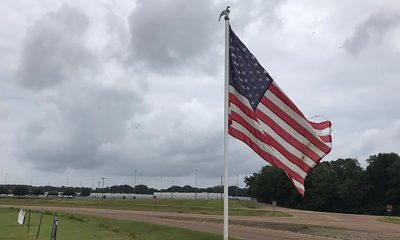Commentary
Why come to Washington Plaza Baptist Church?
It’s about the preaching, the people, and the purpose

BY ZITA COLLINS | I grew up in a Lutheran church before I really knew who I was. Before my own opinions and belief system were formed. Before “welcoming and affirming” churches existed.
I did the “expected” thing: got married to a man, had children, became a wife and a mom. But I knew there was more to me than that, the part I had to keep hidden because of the society “norms” so many years ago. I attended a Mormon church because that was the type of church my husband attended. As I became more myself having my own opinions and thoughts, and my husband tried to be more controlling, the marriage, of course, failed.
I quit church. I moved on in life and met a wonderful woman. I knew there was a God, but I figured since I was “living in sin” He didn’t like me too much. My way of looking at it was “God, you stay in your corner and I’ll stay in mine, and we’ll get along just fine.” Four years later, in September 1982, my partner was diagnosed with cancer. A couple of months later, she passed away.
During those few months my friend invited me to go to her Assembly of God church. I became a regular. One Sunday in January 1983, I gave my heart and life to Christ, becoming a full-fledged believer. And once again, I gradually put away the part of me that was “unacceptable to God.”
As time went on, I attended various churches. I attended an Anglican church for 15 years. I loved God, but I could not reconcile how I felt — my LGBTQ self — with scripture as I knew it at that time. It was at a church leadership meeting, when we were voting on a new marriage policy to exclude gay marriage, that I realized my “calling”: to tell the LGBTQ community that God really loves them and accepts them as they are.
I studied scripture, praying for clarity, and realized that those “clobber verses” have been traditionally misinterpreted, misunderstood, or taken out of context. I began looking for a church that was friendly to the gay community. I learned that the correct terminology is “welcoming and affirming.”
And I found Washington Plaza Baptist Church!
Warm and welcoming, I felt I had found a home. They knew my identity from the start, as I had let it be known that I was looking for a “welcoming and affirming” church. And they loved and accepted me.
So Who is Washington Plaza Baptist Church?
WPBC is a progressive American Baptist church, located on Lake Anne Plaza, with a long and rich history. It was the first church in Reston, Va., a part of Robert E. Simon’s design for the new town named after him. Washington Plaza Baptist Church is an inclusive Christian Community whose worship, communion, and fellowship are open to all. We are a safe place for all people to worship regardless of race, creed, age, cultural background, gender, or sexual orientation. We affirm that all have access to the love of Christ and service to God.
WPBC is very active in Pride. We were involved with the formation of the first Reston Pride and continue to participate each year. We open our fellowship hall for the performers to change and to cool off, and we have a table on the Plaza where we give away free Pride paraphernalia as well as hugs. WPBC has held weddings for same-sex couples — including my wife’s and mine — with most of our members helping in some way to make the day special.
At Washington Plaza Baptist Church, I have been fully embraced for who I am. I have been in leadership from early on. The pastor, Rev. Michelle Nickens, delivers sermons that are powerful and relevant, with a focus on being Christ-like in all areas, including social justice. The people live out their claim of inclusivity and affirmation. The church community truly loves and cares about the people within the church as well as those outside its doors.
Our address is 1615 Washington Plaza West, Reston, Va. Reach us at 703-471 5225, [email protected]. (We’re on Lake Anne Plaza, right next door to the Lake Anne Coffee House and Wine Bar.)
Commentary
History of D.C. Pride: 1995-2007, a time of growth and inclusion
Rainbow History Project plans expansive WorldPride exhibit

In conjunction with WorldPride 2025 the Rainbow History Project is creating an exhibit on the evolution of Pride: “Pickets, Protests, and Parades: The History of Gay Pride in Washington.” In “Freedom on America’s Main Streets,” we discuss how during the 1990s the LGBTQ communities became more prominent across all areas of American life, the circumstances of moving official Pride activities to Pennsylvania Avenue, and the origin of the name “Capital Pride.”
Throughout the 1990s, LGBTQ visibility increased significantly in American society. The LGBTQ community’s presence extended beyond news coverage of AIDS activism, with members participating in various social movements. Gay Black men joined the Million Man March in 1995, carrying banners and signs proclaiming “Black by Birth, Gay by God, Proud by Choice.” Lesbians led abortion-rights rallies, LGBTQ Asians joined Lunar New Year parades, and LGBTQ Latinos marched in Fiesta DC.
Once again, financial difficulties around Pride activities led to the dissolution of the Gay and Lesbian Pride of Washington as an organization and the gay arts and culture non-profit One in Ten took over organizing Pride. One in Ten’s mission was not solely Pride planning, but rather year round activities, including an attempt to make an LGBTQ history museum. Due to the explosion of activities, the crowd sizes, and the growing concerns around feelings of exclusion brought on by the neighborhood’s identity as a primarily gay white male space, in 1995, One in Ten moved the Pride parade and festival out of Dupont Circle to Freedom Plaza on Pennsylvania Avenue.
Although the struggle for bisexual visibility had successfully added the B to the 1993 March on Washington, the push to add Trans and Queer identities to Gay Pride’s name was not yet successful; Pride was reborn as The Freedom Festival. Two years later, in 1997, the Whitman-Walker Clinic became not just a sponsor but also a co-organizer to alleviate some of the organizational and financial challenges. It was during this time that the event was officially renamed Capital Pride.
The name change sparked debate within the community. Frank Kameny, who had organized the 1965 pickets, harshly criticized the new name, arguing that it “certainly provides not an inkling of what we really mean: Pride that we are Gay.” He lamented that the name change “represents Gay shame.” However, others celebrated the inclusivity of the new name. L. A. Nash, a self-identified lesbian, wrote, “Gay is good—Gay, Lesbian, Bisexual and Transgender is far better.” Elke Martin further supported the change, stating, “A name is your identity, it gives you legitimacy and a seat at the table.” Capital Pride’s official name was now “Capital Pride Festival: A Celebration of Lesbian, Gay, Bisexual, Transgendered Community and Friends.”
In April 2000, the Millennium March on Washington highlighted divisions within the gay civil rights movement. Unlike previous grassroots marches organized by local activists, this event was orchestrated by national organizations like the Human Rights Campaign. However, its Millennium Pride Festival was by far the largest event with major headliners performing, including Garth Brooks and Pet Shop Boys. Critics argued that these events represented a corporatization of activism that sidelined political demands and local groups struggling for recognition.
In 2001, Capital Pride events were attracting 100,000 attendees. The festival was held on Pennsylvania Avenue with the U.S. Capitol in the background of the main stage. This location, often referred to as “America’s Main Street,” symbolized a significant visibility boost for the LGBTQ community. However, the Washington Post failed to cover the event beyond a simple listing in its events calendar. The outrage that ensued led Capital Pride director Robert York to state: “This is the biggest and best Pride we’ve had, and it is important to see it covered other than in the gay press.”
It wasn’t until 2007, however, that SaVanna Wanzer, a trans woman of color and Capital Pride board member, successfully established Capital Trans Pride. “The transgender community needs its own event,” Wanzer stated, “rather than just using us as entertainment. That’s all we’ve been allowed to do.” Trans Pride’s creation was a significant step toward greater inclusivity within the LGBTQ community.
Our WorldPride 2025 exhibit, “Pickets, Protests, and Parades: The History of Gay Pride in Washington,” will be installed on Freedom Plaza on May 17 to coincide with DC Trans Pride. We need your help to make it happen.
Commentary
On this Transgender Day of Visibility, we can’t allow this administration to erase us
All people deserve to have our experiences included in the story of this country

By KELLAN BAKER | Since 2009, the world has observed Transgender Day of Visibility (TDOV) each March 31. The importance of ‘visibility’ feels especially significant this year, not only as a trans person but for me as a researcher whose career has been centered on equity and inclusion for transgender people. My work over the past 16 years, which has focused on advancing fairness, access, and transparency in health care for gender diverse populations, could not have prepared me for the speed and cruelty at which the Trump administration has worked to literally erase transgender people from public life.
From banning transgender people from serving openly in the military, blocking access to best practice medical care, and making it all but impossible for us to obtain accurate identification documents that match our gender, the impact of these attacks will be felt for years to come. As a scientist dedicated to fostering the health and wellbeing of diverse communities, I am particularly devastated by the intentional destruction of the federal research infrastructure and statistical systems that are intended to ensure the accurate and comprehensive collection of data on the full diversity of the U.S. population.
The importance of data cannot be understated. This makes the efforts by the federal government to remove survey questions, erase variables from key data sets, and stifle research even more alarming. By simultaneously removing access to existing datasets, removing gender (and other key measures, such as sexual orientation, race, and disability) from key surveys, terminating federal funding for research projects that include trans people, and censoring research projects at federal data centers, this administration’s goal is to erase the lived experiences of trans people – with the idea that if we don’t exist in data and in research, the federal government can claim that we don’t exist at all.
Just in the past two months, we’ve seen a rapid decimation of the inclusion of transgender people in federal research and their visibility in the federal statistical system.
Data sets that included gender measures have disappeared from federal websites. Critical data sets used by federal and state policymakers, public health staff, and researchers, such as the Youth Risk Behavior Surveillance System (YRBSS), were removed from the CDC website in response to a Trump executive order that made it the policy of the administration to recognize only two sexes, male and female. Although some datasets have been put back up, gender variables have been removed.
Surveys that had asked about gender identity no longer do. Claiming that the removal of gender identity measures from key national surveys such as the American Housing Survey, Household Pulse Survey, and National Health Interview Survey were “non-substantial,” the Trump administration has essentially skipped the extensive notice and public comment process that is required to make these types of changes—the same process that were used to add gender identity (and sexual orientation) measures.
In addition, attempts to exclude trans people and other communities facing disparities from surveys will result in a lack of large enough sample sizes to conduct quality data analysis, while reducing any chance of analyzing racial and ethnic differences among trans people.
Hundreds of grants supporting inclusive research have been terminated. The unprecedented move of the National Institutes of Health (NIH) to terminate research grants that include transgender people is just one example of this administration’s rush to eliminate funding from active scientific projects. In many cases, similar agencies are also now required to remove gender identity measures from federally supported surveys. Prominent trans health researchers have watched as their research portfolios are halted, work stopped, staff laid off, and participants left without care.
At the Institute for Health Research & Policy at Whitman-Walker, for example, we have already had seven studies terminated, with a financial impact that exceeds $3 million. One of these cancelled grants was a multi-year, longitudinal study in partnership with the George Washington University to explore the impact of structural racism and anti-LGBTQ bias on HIV risk among young queer and trans people of color nationwide. The notices of termination for this and other awards clearly spell out the administration’s disdain for groundbreaking research that seeks to understand and address health disparities related to LGBTQ populations, particularly trans people.
Censoring research. As seen with recent changes implemented by the CDC, the censorship of gender-related terms on federal websites and scientific publications is intended to further the erasure of evidence detailing the disparities faced by LGBTQ people.
On a day dedicated to honoring the lives and contributions of trans people, the impact that these egregious actions will ultimately have on the health and wellbeing of trans and nonbinary people is chilling. Without access to this knowledge, researchers will not be able to examine the repercussions of the harmful policies put forth by this administration and many states across the country, including bans and restrictions that negatively impact trans people’s physical and mental health, economic security, and educational outcomes.
Although there has been an effort by non-government entities to collect and store previously collected data prior to the Trump administration’s purges, state surveys, private research firms, and academics cannot fill the void left by the federal government’s decision to halt data inclusion. Ensuring that public entities and researchers can continue to use these datasets is only one piece of the puzzle being taken on by groups such as the Data Rescue Project and repositories like Data Lumos. Work also continues thanks to the efforts of the U.S. Trans Survey, the California Health Interview Survey (CHIS), and the important research and analysis of both Gallup and The Pew Research Center. Yet, gaps still exist due to threats of federal funding cuts to organizations committed to safeguarding inclusive data assets in the wake of the administration’s continued assault on trans rights.
This administration suggests that removing one of the only tools available for identifying an entire population of people is a “non-substantial” action. This not only questions the intelligence of the American people but is a direct insult to trans folks everywhere. All people deserve to be counted and to have our experiences included in the story of this country. Transgender people have always been a part of this country, and even if our nation’s surveys choose to exclude us, we continue to exist—authentically, unapologetically, and forever visible.
Kellan Baker, Ph.D., M.P.H, M.A., is executive director of the Institute for Health Research & Policy at Whitman-Walker.
Commentary
Children of American service members defend Pentagon DEI policies
Students protested Defense Secretary Pete Hegseth during Germany visit

“And a little child shall lead them.” (Isaiah 11:6)
Since the new U.S. Defense Secretary Pete Hegseth began his assault on diversity, equality, and inclusion in the U.S. armed forces, hundreds of students at U.S. military schools in Europe and Japan — the children of American servicemembers stationed overseas — have staged walkouts and other demonstrations to protest the new policies.
When Hegseth visited Stuttgart, Germany — the headquarters of U.S. European Command and U.S. Africa Command — on Feb. 11, more than 50 students from the Alexander Patch Middle School held the first of these protests when they left their classes and gathered in the school’s courtyard for an hour-long protest meeting.
More than a hundred students at the Nile Kinnick High School in Yokosuka, the children of Navy parents and Defense Department employees based at Yokosuka, Japan, the headquarters of the U.S. 7th Fleet, walked out of classes and held a protest in the school’s courtyard on Feb. 21, chanting and carrying banners.
“I love this school; I think one of its strengths is its diversity,” said Kinnick High School senior Chase Hassell, president of the student council and leader of the walkout. “I think we have such a great multicultural community, and I think that it’s important for the development of all children — not just us — to have experience with different people of different beliefs and backgrounds,” Hassell told Stars and Stripes after the demonstration.
And on March 6, hundreds of students participated in demonstrations at Humphrey High School at Camp Humphreys, South Korea, and at Ramstein High School and Kaiserslautern High School in Ramstein, Germany, and Wiesbaden High Schools in Wiesbaden, Germany, carrying signs that proclaimed “Solidary in Diversity,” “Censorship is Un-American,” “Our Classrooms Are Not Your Ideological Battleground,” “This Affects People of Color, LGBTQ+, Woman, and Everyone,” and “More Books, Less Bigots!”
There’s a great deal of anger around the country about what the Trump administration is saying and doing. But anger is not enough. These students are not just angry, they’re actually doing something to fight back. Maybe we all have something to learn from them.
Daniel Volman is the director of the African Security Research Project in Washington, D.C., and a specialist on U.S. national security policy toward Africa and African security issues.














